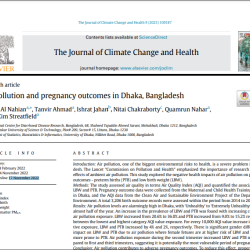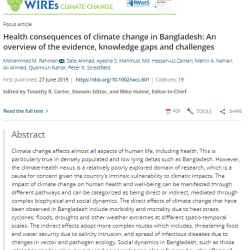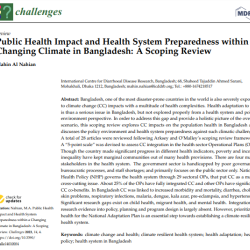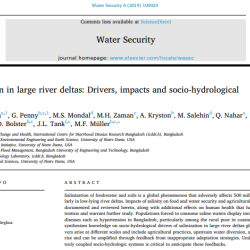Mahin Al Nahian, Ali Ahmed, Attila N. Lázár, Craig W. Hutton, Mashfiqus Salehin, Peter Kim Streatfield
https://doi.org/10.1525/elementa.143 | 09 th January, 2018
Mahin Al Nahian, Ali Ahmed, Attila N. Lázár, Craig W. Hutton, Mashfiqus Salehin, Peter Kim Streatfield
https://doi.org/10.1525/elementa.143 | 09 th January, 2018
ABSTRACT
Salinity intrusion in coastal Bangladesh has serious population health implications, which are yet to be clearly understood. The study was undertaken through the ‘Assessing Health, Livelihoods, Ecosystem Services and Poverty Alleviation in Populous Deltas’ project in coastal Bangladesh. Drinking water salinity and blood pressure measurements were carried out during the household survey campaign. The study explored association among Socio-Ecological Systems (SESs), drinking water salinity and blood pressure.
High blood pressure (prehypertension and hypertension) was found significantly associated with drinking water salinity. People exposed to slightly saline (1000–2000 mg/l) and moderately saline (≥2000 mg/l) concentration drinking water had respectively 17% (p < 0.1) and 42% (p < 0.05) higher chance of being hypertensive than those who consumed fresh water (<1000 mg/l). Women had 31% higher chance of being hypertensive than men. Also, respondents of 35 years and above were about 2.4 times more likely to be hypertensive compared to below 35 years age group. For the 35 years and above age group, both prehypertension and hypertension were found higher than national rural statistics (50.1%) for saline water categories (53.8% for slightly and 62.5% for moderate saline). For moderate salinity exposure, hypertension prevalence was found respectively 21%, 60% and 48% higher than national statistics (23.6%) in consecutive survey rounds among the respondents. Though there was small seasonal variation in drinking water salinity, however blood pressure showed an increasing trend and maximum during the dry season. Mean salinity and associated hypertension prevalence were found higher for deep aquifer (21.6%) compared to shallow aquifer (20.8%).
Localized increase in soil and groundwater salinity was predicted over the study area. Shallow aquifer salinity increase was projected based on modelled output of soil salinity. Rather than uniform increase, there were localized extreme values. Deep aquifer salinity was also predicted to exhibit increasing trend over the period. Study findings and recommendations are suggested for immediate and planned intervention.

lorem ipsum lorem ipsum lorem ipsum lorem ipsum lorem ipsum lorem ipsum lorem ipsum lorem ipsum lorem ipsum lorem ipsum lorem ipsum lorem ipsum

Abstract Climate change affects almost all aspects of human life, including heal

Abstract Bangladesh, one of the most disaster-prone countries in the world is also severely exposed to climate change (CC) impacts with a multitude of health comple

Abstract Salinization of freshwater and soils is a global phenomenon that adversely affects 500 million people, particularly in low-lying riv

lorem ipsum lorem ipsum lorem ipsum lorem ipsum lorem ipsum lorem ipsum lorem ipsum lorem ipsum lorem ipsum lorem ipsum lorem ipsum lorem ipsum
This website was produced with the support of the United States Agency for International Development (USAID) under the terms of USAID's Research for Decision Makers (RDM) Activity cooperative agreement no. AID-388-A-17-00006
Views expressed herein do not necessarily reflect the views of the U.S. Government or USAID. icddr,b is also grateful to the Governments of Bangladesh, Canada, Sweden and the UK for providing unrestricted/institutional support
68, Shaheed Tajuddin Ahmed Sarani Mohakhali, Dhaka 1212, Bangladesh
icddr,b is located at the Mohakhali area in Dhaka, just ask your driver for the "Cholera Hospital"
